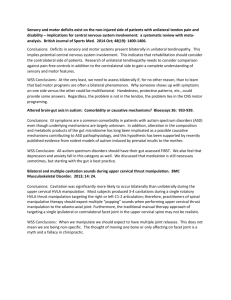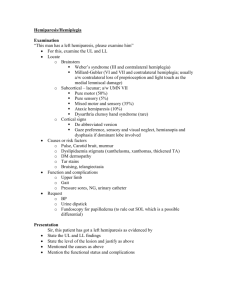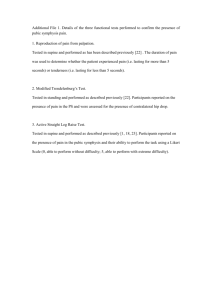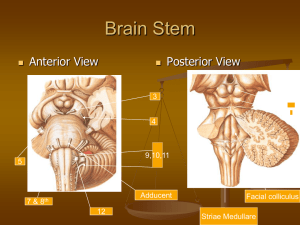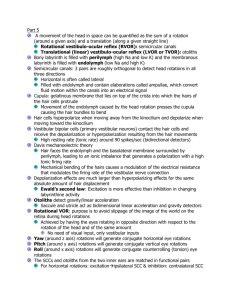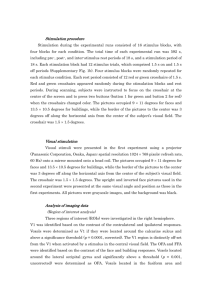Contralateral effects of unilateral strength training
advertisement
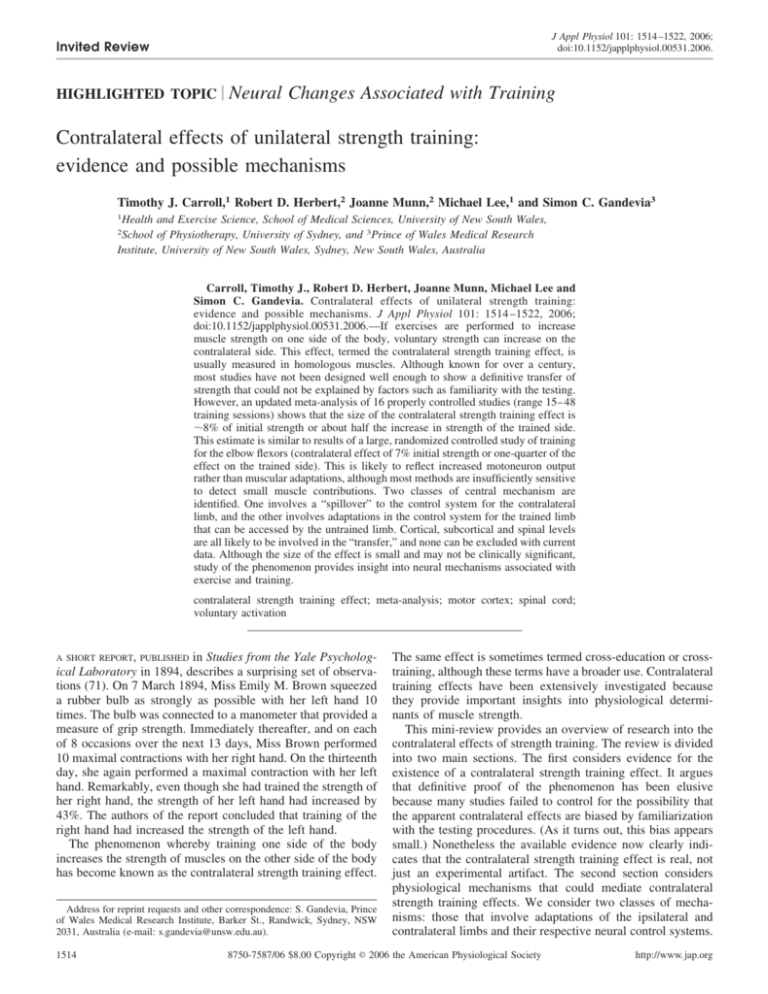
J Appl Physiol 101: 1514 –1522, 2006; doi:10.1152/japplphysiol.00531.2006. Invited Review HIGHLIGHTED TOPIC Neural Changes Associated with Training Contralateral effects of unilateral strength training: evidence and possible mechanisms Timothy J. Carroll,1 Robert D. Herbert,2 Joanne Munn,2 Michael Lee,1 and Simon C. Gandevia3 1 Health and Exercise Science, School of Medical Sciences, University of New South Wales, School of Physiotherapy, University of Sydney, and 3Prince of Wales Medical Research Institute, University of New South Wales, Sydney, New South Wales, Australia 2 Carroll, Timothy J., Robert D. Herbert, Joanne Munn, Michael Lee and Simon C. Gandevia. Contralateral effects of unilateral strength training: evidence and possible mechanisms. J Appl Physiol 101: 1514 –1522, 2006; doi:10.1152/japplphysiol.00531.2006.—If exercises are performed to increase muscle strength on one side of the body, voluntary strength can increase on the contralateral side. This effect, termed the contralateral strength training effect, is usually measured in homologous muscles. Although known for over a century, most studies have not been designed well enough to show a definitive transfer of strength that could not be explained by factors such as familiarity with the testing. However, an updated meta-analysis of 16 properly controlled studies (range 15– 48 training sessions) shows that the size of the contralateral strength training effect is ⬃8% of initial strength or about half the increase in strength of the trained side. This estimate is similar to results of a large, randomized controlled study of training for the elbow flexors (contralateral effect of 7% initial strength or one-quarter of the effect on the trained side). This is likely to reflect increased motoneuron output rather than muscular adaptations, although most methods are insufficiently sensitive to detect small muscle contributions. Two classes of central mechanism are identified. One involves a “spillover” to the control system for the contralateral limb, and the other involves adaptations in the control system for the trained limb that can be accessed by the untrained limb. Cortical, subcortical and spinal levels are all likely to be involved in the “transfer,” and none can be excluded with current data. Although the size of the effect is small and may not be clinically significant, study of the phenomenon provides insight into neural mechanisms associated with exercise and training. contralateral strength training effect; meta-analysis; motor cortex; spinal cord; voluntary activation A SHORT REPORT, PUBLISHED in Studies from the Yale Psychological Laboratory in 1894, describes a surprising set of observations (71). On 7 March 1894, Miss Emily M. Brown squeezed a rubber bulb as strongly as possible with her left hand 10 times. The bulb was connected to a manometer that provided a measure of grip strength. Immediately thereafter, and on each of 8 occasions over the next 13 days, Miss Brown performed 10 maximal contractions with her right hand. On the thirteenth day, she again performed a maximal contraction with her left hand. Remarkably, even though she had trained the strength of her right hand, the strength of her left hand had increased by 43%. The authors of the report concluded that training of the right hand had increased the strength of the left hand. The phenomenon whereby training one side of the body increases the strength of muscles on the other side of the body has become known as the contralateral strength training effect. Address for reprint requests and other correspondence: S. Gandevia, Prince of Wales Medical Research Institute, Barker St., Randwick, Sydney, NSW 2031, Australia (e-mail: s.gandevia@unsw.edu.au). 1514 The same effect is sometimes termed cross-education or crosstraining, although these terms have a broader use. Contralateral training effects have been extensively investigated because they provide important insights into physiological determinants of muscle strength. This mini-review provides an overview of research into the contralateral effects of strength training. The review is divided into two main sections. The first considers evidence for the existence of a contralateral strength training effect. It argues that definitive proof of the phenomenon has been elusive because many studies failed to control for the possibility that the apparent contralateral effects are biased by familiarization with the testing procedures. (As it turns out, this bias appears small.) Nonetheless the available evidence now clearly indicates that the contralateral strength training effect is real, not just an experimental artifact. The second section considers physiological mechanisms that could mediate contralateral strength training effects. We consider two classes of mechanisms: those that involve adaptations of the ipsilateral and contralateral limbs and their respective neural control systems. 8750-7587/06 $8.00 Copyright © 2006 the American Physiological Society http://www. jap.org Invited Review CONTRALATERAL EFFECTS OF UNILATERAL STRENGTH TRAINING A hierarchical approach is taken, considering peripheral, spinal, and then cortical and other supraspinal mechanisms. In the last section, we assess the potential utility of the cross-training effect and some of the lessons that have been learned from studying it. EVIDENCE OF A CONTRALATERAL STRENGTH TRAINING EFFECT The early observations on Miss Brown are not convincing, not least because, in addition to squeezing the rubber bulb, Miss Brown concurrently exercised both arms by lifting dumbbells during the course of the experiment. Another limitation is that the observations were made only on one subject, so there is no formal basis for generalization of the phenomenon to other people. The value of this study was not that it demonstrated the existence of a contralateral training effect but that it began an extensive program of research. Now, well over a 100 years later, many studies have attempted to demonstrate contralateral training effects. Most often the approach is as follows: the strength of both right and left limbs is measured. Then, the right and left limbs of each subject are allocated to training and control conditions. In well-designed studies, allocation is random, but many studies use nonrandom allocation. Subjects perform a unilateral strength training program, after which strength of right and left limbs is remeasured. The increase in strength of the untrained limb is used to estimate the size of the contralateral strength training effect. Interpretation of such studies (which we will call withinsubject studies) is difficult. One difficulty is that the process of measuring the strength of the untrained arm before the training period could itself increase performance in subsequent strength tests. A single session of training is sufficient to produce increases in strength (66). Consequently increases in the strength of the untrained limb observed in within-subject studies could simply be a training response to the procedures used to measure strength before the training program. Similarly, apparent contralateral effects could be attributed to familiarity with testing procedures. If, as is usually the case, the training procedures resemble the testing procedures, training will familiarize the subjects with testing procedures. Over the course of the training program subjects may learn to position themselves optimally in the test apparatus, or to exert force against a dynamometer in an optimal direction. Consequently it may be familiarization with the testing protocol, rather than the repeated execution of training contractions, which has contralateral effects. Can familiarization with testing procedures be considered to be a part of training? Can we call familiarization-induced increases in strength “training responses”? Is it of interest to know that familiarization with test procedures increases contralateral strength? And is familiarization with test procedures a legitimate focus of physiological enquiry? These are difficult questions that we will not attempt to answer. In this minireview, we will focus on training effects that are a direct consequence of repeated execution of strong muscle contractions in the opposite limb over the course of a training program, rather than familiarization with testing procedures. For this perspective, a higher degree of experimental control is necessary. More control can be achieved by randomizing J Appl Physiol • VOL 1515 subjects (rather than limbs) to groups. Subjects in one group train with one limb, and subjects in the other group do not train at all. Ideally, both groups attend the laboratory for the same number of sessions, although in many of these studies the untrained subjects only attend the laboratory before and after the experimental period. With this design, which we will call the between-subjects design, the contralateral effect of strength training is estimated by subtracting the mean strength of the untrained limbs of untrained subjects from the mean strength of the untrained limbs of trained subjects. Alternatively, contralateral effects may be estimated by subtracting the mean change in strength of the untrained limbs of untrained subjects from the mean change in strength of the untrained limbs of trained subjects. Another possibility is to compare the strengths of untrained limbs of trained and untrained subjects after adjusting for baseline strength in an analysis of covariance. The common feature of these approaches is that they contrast strength of untrained limbs of trained and untrained subjects. Because both trained and untrained subjects have become familiar with the test procedures, such estimates control for training effects by familiarization. Unfortunately, even between-subject studies of contralateral strength training effects often do not provide estimates of contralateral training effects based on between-group comparisons. Instead, they report the change in strength of the untrained arm of trained subjects. By doing so, they forfeit the experimental control conferred by the between-subjects design. Another problem is that most individual studies have small sample sizes (typically such studies have sample sizes of ⱕ20), so they may fail to detect physiologically interesting effects even if such effects exist. These shortcomings can be overcome with meta-analysis. A meta-analysis of published data can pool between-subject estimates of contralateral training effects, which potentially provides an adequate level of statistical power. We recently conducted a systematic review and meta-analysis of randomized between-subject studies of the contralateral effects of training. The review identified 17 studies in which subjects trained with an intensity of at least 50% of maximal voluntary strength for a minimum of 2 wk (62). Of these, 13 studies provided estimates of the size of the contralateral training effect (8, 20, 26, 33, 35, 45, 47, 49, 56, 73–75, 88). Since that review was conducted, three further studies have been published that meet the criteria for inclusion in the original systematic review (24, 52, 63), so we have updated the findings of the review with data published in the intervening period. Most studies trained the knee extensors or elbow flexors isometrically or isokinetically using maximal voluntary contractions. Sample sizes of individual studies were typically small (median group size of 10). Figure 1 shows the distribution of the 16 estimates of contralateral training effects. The pooled estimate is that unilateral training of the periods and intensities observed in these studies (4 –12 wk, 15– 48 training sessions, intensities of ⬃55– 100% of a maximal contraction) increases contralateral strength by, on average, 7.6% of initial strength (random effects model). This corresponds to an increase in contralateral strength of 52% of the ipsilateral training effect. The same studies can be used to assess the magnitude of the bias in within-subject estimates of the contralateral effects, because each of the 16 between-subject studies also provides 101 • NOVEMBER 2006 • www.jap.org Invited Review 1516 CONTRALATERAL EFFECTS OF UNILATERAL STRENGTH TRAINING Fig. 1. Distribution of estimates, from 16 studies, of effects of unilateral strength training on contralateral strength. Each of the 16 estimates (■) is calculated from the difference in mean strength of the untrained limb of trained subjects and an untrained limb in control subjects who did not train. The study from which each estimate is obtained is given at left. The size of each square is proportional to the study’s sample size. Horizontal bars, 95% confidence intervals. }, Pooled estimate (random-effects model) of the contralateral training effect based on all 16 studies. data that can be used to generate within-subject estimates. The pooled within-subjects estimate (random effects, 16 studies) of 11.0% is slightly greater than the between-subject estimates (7.6%). This difference is small, so it suggests that familiarization with testing procedures produces only a small bias in within-subject estimates. The findings of the meta-analyses have been confirmed by a recent large randomized between-subject study (63). In this study, 115 subjects were randomized to groups that trained (n ⫽ 92) or did not train (n ⫽ 23) the elbow flexors by lifting free weights with one arm. All subjects attended the laboratory for 18 supervised sessions over 6 –7 wk, and subjects in the training groups performed three training sets per session at a load they could lift at most six to eight times. Untrained subjects attended the laboratory and were seated at the testing apparatus for 18 sessions, but they did not train. Unilateral training increased contralateral strength, compared with the control condition, by an average of 7% of initial strength, or about one-quarter of the increase in strength on the trained limb. Lower volumes of training (1 set instead of 3) did not produce discernable increases in contralateral strength. In summary, the best available evidence suggests the contralateral training effect is real but small. In the next section we consider the mechanisms that might underlie these effects. POSSIBLE MECHANISMS FOR THE CONTRALATERAL STRENGTH TRAINING EFFECT The precise physiological mechanisms that underlie the contralateral transfer of muscular strength after training are not known. The purpose of this section is to identify which of the many potential sites of adaptation are plausible mechanisms for the effect (also see Ref. 32 for recent reviews). Conceptually J Appl Physiol • VOL there are two different classes of mechanism by which forcegenerating capacity could increase in the untrained, opposite limb. First, unilateral strength training could cause a “spillover” of neural drive to the untrained side that induces adaptations in the control system for the opposite limb; and second, unilateral strength training could cause neuromuscular adaptations in the control system for the trained limb that can be accessed by the opposite limb. These alternatives may not be mutually exclusive, and it is possible that adaptations from both classes may be involved in the effect. When one considers that there may be multiple sites of adaptation, and that the magnitude of the contralateral strength training effect is typically small, it is clear that sensitive physiological measures may be needed establish the underlying mechanisms. This may be one reason for the lack of success to date in directly identifying the physiological causes of the contralateral strength training effect. In this section, we describe a number of potential sites of adaptation, moving systematically from the muscle to the cortex. We aim to highlight known sources of cross-limb neuromuscular interaction and to identify which of these factors are most likely to contribute to the contralateral strength training effect. Muscular mechanisms. Adaptations within the muscles engaged in strength training contribute to increases in forcegenerating capacity (for review see Refs. 2, 5, 6). These changes include hypertrophy, changes in muscle enzyme concentrations, and modifications in contractile protein composition (e.g., fiber-type proportions). Studies in which anthropometric (59), imaging (64, 68), or histological (34, 38, 68) measurements were made of fiber type and/or muscle crosssectional area showed no evidence that unilateral strength training causes contralateral muscular adaptations. However, the possibility that muscle effects are involved in the contralateral strength training effect should not be dismissed on this evidence alone, because it is likely that these methods lack sensitivity to detect small-muscle adaptations. The issue of whether muscle adaptations are involved in the contralateral strength training effect can also be approached by considering the processes that might drive muscular adaptations in the untrained limb. The most obvious are the anabolic hormonal changes that accompany resistance training, because systemic mediators of this type have ready access to muscles in the untrained limb. However, if hormonally driven adaptations were a major contributor to the contralateral strength training effect, it would be difficult to explain the observation that the effect is specific to the contralateral, homologous muscles. In fact, there is evidence that the strength of nonhomologous muscles is unaffected by strength training (30, 36, 88). However, although the comparisons between the contralateral strength training effect on homologous vs. nonhomologous muscles is important, there are probably insufficient data to establish this point with certainty. It remains to be established whether the contralateral effect has major joint specificity. It might also be expected that the contralateral strength training effect would be greatest when larger muscle groups are trained [because these generate greater hormonal changes (50)], whereas contralateral strength training effects of comparable magnitude can be induced in small hand muscles (88). Conventional thinking suggests unilateral training probably produces too little motor unit activation in the untrained limb 101 • NOVEMBER 2006 • www.jap.org Invited Review CONTRALATERAL EFFECTS OF UNILATERAL STRENGTH TRAINING to drive muscular adaptation. A small degree of muscle activity was reported in some studies in the untrained limb during unilateral resistance training (18, 24, 38, 90). However, the contralateral strength training effect also occurs in the absence of significant contralateral activity (20, 35). It is difficult to conceive how significant muscular adaptations could be induced without appreciable motor unit activity. In summary, a critical analysis of the evidence suggests that peripheral muscle adaptations are unlikely to contribute substantially to the contralateral strength training effect, but the possibility of a small contribution cannot be ruled out. Neural mechanisms. If the contralateral strength training effect is not due to muscular mechanisms, the effect must be mediated by a change in the way that muscles are activated by the central nervous system. That is, neural drive could be increased to agonist and synergist muscles or reduced to antagonist muscles. It is important to recognize that much of the evidence for neural mechanisms of contralateral training effects has been drawn from surface electromyogram (EMG) studies, and this is questionable for methodological reasons that have been highlighted elsewhere (10, 23, 25). In particular, the idea that reduced antagonist coactivation is an important mechanism for increases in strength may have arisen from undetected volume conduction in the surface EMG, because intramuscular EMG recordings confirm near-complete quiescence in antagonist muscles during elbow flexion maximal voluntary contraction (3). There is also evidence that strength training can increase peak firing rates and increase the occurrence of doublets at 1517 onset of contraction (84), and it may also alter motor unit synchronization (57, 72, 89). If these adaptations occurred on the untrained side, there could be quite complex relations between the surface EMG and the force that would make interpretation of the surface EMG problematic (23). Candidate mechanisms for this type of adaptation include changes in the pattern of neural activity associated with motor drive and adaptive modifications in neural circuits involved in motor planning and execution. It is also to be expected that the neural mechanisms for the contralateral strength training effect parallel, to some extent, the neural adaptations that induce strength increases in the trained limb after resistance training. However, because the precise nature of neural adaptations in the trained limb is not known, consideration of the mechanisms underlying the contralateral strength training effect is restricted to identifying sites of cross-limb neural interaction that could contribute to force production on the opposite side of the body (see Figs. 2 and 3 and Ref. 12 for review). Spinal cord mechanisms. There is a complex network of circuits in the spinal cord that influences motor output, both via reflex actions on motoneurons and by modulating descending commands (67). This circuitry shapes motor drive to agonists, synergists and antagonists, and thereby influences force-generating capacity. The fundamental actions (i.e., neuronal sources and inhibitory/excitatory effects) of many circuits have been identified (Fig. 2; for review see Refs. 41, 67); however, much still remains unknown about task-dependent regulation of these actions and about the role of more complex polysynaptic circuits. Fig. 2. Illustration of the segmental network that contributes to motor output in each limb, with known cross-hemicord connections depicted in bold. GTO, Golgi tendon organ; RC, Renshaw cells; IaIN, Ia inhibitory interneuron; IbIN, Ib inhibitory interneuron; MN, motoneuron; PIN, presynaptic inhibition interneuron; PN, propriospinal interneuron; CIN, commissural interneuron; Antag, antagonist. Note that one neuron is used to represent both inhibitory and excitatory CINs. F, Inhibitory connections. J Appl Physiol • VOL 101 • NOVEMBER 2006 • www.jap.org Invited Review 1518 CONTRALATERAL EFFECTS OF UNILATERAL STRENGTH TRAINING Fig. 3. Representation of the supraspinal network involved in movement control in each limb, with cross-hemispheric connections depicted via bold lines. Note that the pyramidal decussation is not shown. PFC, prefrontal cortex; BG, basal ganglia; CB, cerebellum; PM, pre-motor cortex; SMA, supplementary motor area; B Stem, brain stem nuclei. There is some evidence that spinal circuitry is modified by strength training, although most of the techniques that have been used to study this phenomenon do not allow the identification of specific sites of adaptation (1, 11, 52). In the only study to date that has investigated whether unilateral training causes changes in the untrained hemicord, Lagerquist et al. (52) found no change in H-reflex amplitude in the opposite, untrained limb after an isometric training program that increased H-reflex amplitude in the trained limb. While this suggests that adaptations in the autogenic stretch reflex circuit are not a major contributor to contralateral strength-training effect, it does not preclude the involvement of other spinal circuits. Adaptation of other spinal circuits is plausible, because unilateral contraction or movement results in gain modulation of contralateral spinal circuits. Hortobagyi and colleagues (37) showed that strong unilateral wrist flexion depressed H-reflex gain in the contralateral wrist flexors, most likely through an atypical, prolonged form of presynaptic inhibition of Ia afferent-motoneuron synapses. Contralateral rhythmic movements also depress H-reflex gain in both the upper and lower limbs (13, 55), and the fact that modulation occurs during both active and passive movement suggests afferent inputs play a role. In cats, interneurons that receive afferent and descending inputs cross the midline to excite or inhibit contralateral motoneurons (commissural interneurons), and they are located in spinal lamina VIII (42, 43) (see Fig. 2). It seems likely that interneurons of this type contribute to crossed effects in humans, because Delwaide and Pepin (16) showed that contralateral afferent stimulation causes reflex conditioning in a pattern consistent with the synaptic organization of the cat. Although there are extensive cross-limb spinal interactions during unilateral contraction, experiments J Appl Physiol • VOL that directly compare changes in the threshold and gain of specific circuits in both the trained and untrained limb are needed to determine which of these are likely mechanisms for cross-education. Cortical mechanisms. An extensive network of circuits distributed (mainly) throughout the frontal lobes of the cerebral cortex is involved in the planning and execution of voluntary movement (see Fig. 3). These motor areas are organized in a loosely hierarchical manner: from higher order decision making and planning in prefrontal regions to relatively direct control of motoneuronal output at the primary motor cortex (M1). Although there is strong evidence that motor learning is associated with cortical reorganization (48, 61, 65), there is no definitive evidence that strength training causes cortical adaptations (11, 44) (cf. Ref. 69). However, there are interhemispheric connections via the corpus callosum between most cortical motor areas, as well as bilateral and ipsilateral corticospinal projections to many proximal muscles (Fig. 3; for review see Ref. 12). Thus there are numerous sites of crosslimb cortical interaction that could contribute to the contralateral strength training effect. Of these sites, uncrossed corticospinal fibers that target ipsilateral motoneurons and branched corticospinal fibers that project to motoneurons bilaterally seem least likely to have a major role in the contralateral strength training effect. This is because these projections are strongest to axial muscles, and may be absent for distal limb muscles, whereas contralateral strength training effects of similar magnitude can be induced throughout the body, including the hand (7, 9, 32, 62). Some types of interhemispheric interaction provide a plausible basis for the first class of mechanism that could mediate the contralateral strength training effect. That is, strong con- 101 • NOVEMBER 2006 • www.jap.org Invited Review CONTRALATERAL EFFECTS OF UNILATERAL STRENGTH TRAINING traction of one limb affects the gain of ipsilateral cortical circuitry that, with repeated execution, could induce adaptations in the “untrained” control system to allow more effective motor drive when the untrained limb is maximally contracted. Moderate to strong unilateral contractions (i.e., ⬎40% MVC) facilitate responses to transcranial magnetic stimulation (TMS) in the resting limb (31, 37, 54, 60, 77, 78), although some types of unilateral contraction depress these motor cortex-evoked potentials in the opposite limb (54). This may be due in part to the existence of both excitatory and inhibitory cross-hemispheric M1-M1 connections (19, 29, 76) and possibly to dorsal pre-motor cortex-M1 connections (58). Another possibility is that modulation of ipsilateral M1 excitability is due to common inputs to both M1s from higher order cortical areas involved in motor planning. Unilateral training could conceivably cause adaptations in cortical areas involved in motor function other than M1, because there are callosal connections between bilateral supplementary motor areas, cingulate motor areas, and prefrontal areas (40, 70), and imaging data suggest that these areas are activated during unilateral contraction (17, 46). However, despite these cross-hemispheric interactions, there is no evidence that unilateral motor activity can induce adaptations in the ipsilateral motor cortex. Studies that directly assess whether there is functional reorganization of the ipsilateral hemisphere after unilateral strength training are needed to test this possibility. Neuroimaging methods may seem promising here, but they have serious limitations. For example, they do not usually distinguish between an excitatory or inhibitory activation, or whether any change involves the input to or output from the cortical region. Hence, it is difficult to separate an epiphenomenon from a change that actually enhances motoneuronal output on the untrained side. The basic idea behind the second class of mechanism that could underlie the contralateral strength training effect is that processing in the ipsilateral hemisphere can assist with unilateral motor execution. Evidence that this occurs comes from imaging studies (27, 46, 86), lesion studies (28), and TMS studies (14, 79). The study by Strens et al. (79) provides an elegant example of the major concepts associated with this class of mechanism, although the context bears little resemblance to strength training. When the excitability of both motor cortices was depressed by bilateral repetitive TMS (rTMS), participants lost the ability to accurately match a target force during finger tapping. However, when only the hemisphere contralateral to the moving limb was stimulated, force output was not affected. This indicates that the ipsilateral cortex is able to contribute the force regulation when the contralateral cortex is unavailable. There are interhemispheric asymmetries in the capacity for the ipsilateral cortex to contribute to unilateral motor control. In most subjects, the left hemisphere (that projects to the dominant limb of right-handed subjects) has a greater role in controlling the left limb than does the right hemisphere in controlling the right limb (21, 46, 86). The fact that the contralateral strength training effect is also greatest when the right limb is trained (24) supports the second class of mechanism; it suggests that circuits in the control system for the trained right limb (i.e., left hemisphere) can be accessed to increase the strength of the untrained left limb. J Appl Physiol • VOL 1519 Subcortical mechanisms. Comparatively little is known about the potential for cross-limb neural interaction at subcortical centers involved in movement control, such as the basal ganglia, cerebellum and brain stem nuclei that give rise to nonpyramidal descending tracts (e.g., reticulospinal and vestibulospinal tracts). However, unilateral lesions of both basal ganglia and cerebellar circuits result in motor deficits on both sides of the body (39, 85). Furthermore, there are interhemispheric anatomic connections within the corticosubcortical loops associated with both structures (22, 87). In cats, brain stem nuclei are capable of exerting cross-limb effects via projections to commissural interneurons (51). The involvement of propriospinal interneurons in bilateral interactions between the hemicords is also possible (67). Although there is currently no evidence that subcortical circuits typically involved in motor execution of the opposite limb contribute to high-force unilateral contractions in humans, the existence of anatomical substrates for cross-limb interaction suggests that such a role may well exist. Thus, at present, the possibility that subcortical brain areas are involved in the contralateral strength training effect cannot be excluded. FINAL PERSPECTIVE This brief review has highlighted a number of intriguing aspects of the contralateral strength training effect. Although the phenomenon was described over a century ago, many studies have not been designed well enough to expose the magnitude of the effect. Theoretically, experiments using a within-subjects design have a weakness in that subject familiarity with the testing potentially confounds the results. However, when this weakness is set aside and data from betweensubjects designs are considered, meta-analysis supports the presence of a contralateral strength training effect (Fig. 1; see also Ref. 62). Meta-analysis also indicates that although familiarity with testing procedures does improve contralateral performance, the effect is rather small (just 3% of initial strength), presumably because modern testing conditions usually promote high levels of voluntary activation (25). The updated meta-analysis indicates that although the contralateral strength training effect is small, it is robust and occurs for muscles in both the upper and lower limb, with the elbow flexors and the knee extensors being most frequently tested. A large randomized controlled trial of the elbow flexors confirmed the presence and size of the contralateral effect using the elbow flexor muscles (63). Given that the bulk of the effect is likely to reflect increased output from the homologous contralateral motoneuron pools, it notable that the size of the effect fits well with known levels of voluntary activation for the muscle group involved (3). Studies using peripheral nerve stimulation with valid methods of twitch interpolation (3, 4) and more recently with cortical stimulation (82, 83) suggest that healthy subjects usually reach 90 –95% of peak voluntary activation in tests under optimal laboratory conditions (25). Interpolation using TMS further indicates that output from the motor cortex is not maximal during voluntary effort and that it can be effectively supplemented by artificial stimulation. This “reserve” is available to be accessed after training. This method, unlike twitch interpolation with nerve stimulation (4), provides a measure of voluntary activation, which is directly proportional to force (83). 101 • NOVEMBER 2006 • www.jap.org Invited Review 1520 CONTRALATERAL EFFECTS OF UNILATERAL STRENGTH TRAINING Given the size of the contralateral strength training effect, one must ask whether it is likely to be clinically significant: is it clinically useful to train one limb to generate a strength increase on the untrained side? Training typically produces at least twice the strength gains produced by “passive transfer” to the untrained side. Hence it would usually be better to train the affected limb. In the clinical context, this means training the muscle group that requires strengthening or the group that is weakened by disease, disuse, or injury. It is not clear whether additional training of the unaffected limb enhances the improvement in strength of an affected limb that is also being trained, but this could be tested formally. However, if present, the effect is likely to be small and may not lead to significant improvement in performance of activities of daily living. Some data even suggest that contralateral training may actually harm performance in people with unilateral brain and that limb constraint, rather than training, may improve performance (80). It must be emphasized that this conclusion may not apply to other aspects of cross-education such as skill acquisition where practice with the contralateral limb may provide benefit (15, 53, 81). Irrespective of debate about the potential utility of the contralateral strength training effect, studies of the phenomenon open the way to investigate many aspects of the cortical, subcortical, and spinal control of movement. Many small changes may combine to produce the overall contralateral increase in strength and they will have different time courses and operate to different degrees in different subjects. The availability of new physiological techniques will make it possible to subject these mechanisms greater scrutiny in the near future. GRANTS The work of the authors’ laboratories is supported by the National Health and Medical Research Council of Australia and the Australian Research Council. REFERENCES 1. Aagaard P, Simonsen EB, Andersen JL, Magnusson P, and DyhrePoulsen P. Neural adaptation to resistance training: changes in evoked V-wave and H-reflex responses. J Appl Physiol 92: 2309 –2318, 2002. 2. Abernethy PJ, Jurimae J, Logan PA, Taylor AW, and Thayer RE. Acute and chronic response of skeletal muscle to resistance exercise. Sports Med 17: 22–38, 1994. 3. Allen GM, Gandevia SC, and McKenzie DK. Reliability of measurements of muscle strength and voluntary activation using twitch interpolation. Muscle Nerve 18: 593– 600, 1995. 4. Allen GM, McKenzie DK, and Gandevia SC. Twitch interpolation of the elbow flexor muscles at high forces. Muscle Nerve 21: 318 –328, 1998. 5. Baldwin KM and Haddad F. Effects of different activity and inactivity paradigms on myosin heavy chain gene expression in striated muscle. J Appl Physiol 90: 345–357, 2001. 6. Booth FW and Baldwin KM. Muscle plasticity: energy demand and supply processes. In: Handbook of Physiology. Exercise: Regulation and Integration of Multiple Systems. Bethesda, MD: Am. Physiol Soc., 1996, sect. 12, chapt. 24, p. 1075–1123. 7. Brinkman J and Kuypers HG. Cerebral control of contralateral and ipsilateral arm, hand and finger movements in the split-brain rhesus monkey. Brain 96: 653– 674, 1973. 8. Carolan B and Cafarelli E. Adaptations in coactivation after isometric resistance training. J Appl Physiol 73: 911–917, 1992. 9. Carr LJ, Harrison LM, and Stephens JA. Evidence for bilateral innervation of certain homologous motoneurone pools in man. J Physiol 475: 217–227, 1994. 10. Carroll TJ, Riek S, and Carson RG. Neural adaptations to resistance training: implications for movement control. Sports Med 31: 829 – 840, 2001. J Appl Physiol • VOL 11. Carroll TJ, Riek S, and Carson RG. The sites of neural adaptation induced by resistance training in humans. J Physiol 544: 641– 652, 2002. 12. Carson RG. Neural pathways mediating bilateral interactions between the upper limbs. Brain Res Brain Res Rev 49: 641– 662, 2005. 13. Carson RG, Riek S, Mackey DC, Meichenbaum DP, Willms K, Forner M, and Byblow WD. Excitability changes in human forearm corticospinal projections and spinal reflex pathways during rhythmic voluntary movement of the opposite limb. J Physiol 560: 929 –940, 2004. 14. Chen R, Gerloff C, Hallett M, and Cohen LG. Involvement of the ipsilateral motor cortex in finger movements of different complexities. Ann Neurol 41: 247–254, 1997. 15. Criscimagna-Hemminger SE, Donchin O, Gazzaniga MS, and Shadmehr R. Learned dynamics of reaching movements generalize from dominant to nondominant arm. J Neurophysiol 89: 168 –176, 2003. 16. Delwaide PJ and Pepin JL. The influence of contralateral primary afferents on Ia inhibitory interneurones in humans. J Physiol 439: 161– 179, 1991. 17. Dettmers C, Ridding MC, Stephan KM, Lemon RN, Rothwell JC, and Frackowiak RS. Comparison of regional cerebral blood flow with transcranial magnetic stimulation at different forces. J Appl Physiol 81: 596 – 603, 1996. 18. Devine KL, LeVeau BF, and Yack HJ. Electromyographic activity recorded from an unexercised muscle during maximal isometric exercise of the contralateral agonists and antagonists. Phys Ther 61: 898 –903, 1981. 19. Di Lazzaro V, Oliviero A, Profice P, Insola A, Mazzone P, Tonali P, and Rothwell JC. Direct demonstration of interhemispheric inhibition of the human motor cortex produced by transcranial magnetic stimulation. Exp Brain Res 124: 520 –524, 1999. 20. Evetovich TK, Housh TJ, Housh DJ, Johnson GO, Smith DB, and Ebersole KT. The effect of concentric isokinetic strength training of the quadriceps femoris on electromyography and muscle strength in the trained and untrained limb. J Strength Condition Res 15: 439 – 445, 2001. 21. Fadiga L, Buccino G, Craighero L, Fogassi L, Gallese V, and Pavesi G. Corticospinal excitability is specifically modulated by motor imagery: a magnetic stimulation study. Neuropsychologia 37: 147–158, 1999. 22. Fallon JH and Loughlin SE. Substantia nigra. In: The Rat Nervous System, edited by Paxinos G. San Diego, CA: Academic, 1995, p. 215–232. 23. Farina D, Merletti R, and Enoka RM. The extraction of neural strategies from the surface EMG. J Appl Physiol 96: 1486 –1495, 2004. 24. Farthing JP, Chilibeck PD, and Binsted G. Cross-education of arm muscular strength is unidirectional in right-handed individuals. Med Sci Sports Exerc 37: 1594 –1600, 2005. 25. Gandevia SC. Spinal and supraspinal factors in human muscle fatigue. Physiol Rev 81: 1725–1789, 2001. 26. Garfinkel S and Cafarelli E. Relative changes in maximal force, EMG, and muscle cross-sectional area after isometric training. Med Sci Sports Exerc 24: 1220 –1227, 1992. 27. Haaland KY, Elsinger CL, Mayer AR, Durgerian S, and Rao SM. Motor sequence complexity and performing hand produce differential patterns of hemispheric lateralization. J Cogn Neurosci 16: 621– 636, 2004. 28. Haaland KY, Harrington DL, and Knight RT. Neural representations of skilled movement. Brain 123: 2306 –2313, 2000. 29. Hanajima R, Ugawa Y, Machii K, Mochizuki H, Terao Y, Enomoto H, Furubayashi T, Shiio Y, Uesugi H, and Kanazawa I. Interhemispheric facilitation of the hand motor area in humans. J Physiol 531: 849 – 859, 2001. 30. Herbert RD, Dean C, and Gandevia SC. Effects of real and imagined training on voluntary muscle activation during maximal isometric contractions. Acta Physiol Scand 163: 361–368, 1998. 31. Hess CW, Mills KR, and Murray NM. Magnetic stimulation of the human brain: facilitation of motor responses by voluntary contraction of ipsilateral and contralateral muscles with additional observations on an amputee. Neurosci Lett 71: 235–240, 1986. 32. Hortobagyi T. Cross education and the human central nervous system. IEEE Eng Med Biol Mag 24: 22–28, 2005. 33. Hortobagyi T, Barrier J, Beard D, Braspennincx J, Koens P, Devita P, Dempsey L, and Lambert J. Greater initial adaptations to submaximal muscle lengthening than shortening. J Appl Physiol 81: 1677–1682, 1996. 101 • NOVEMBER 2006 • www.jap.org Invited Review CONTRALATERAL EFFECTS OF UNILATERAL STRENGTH TRAINING 34. Hortobagyi T, Hill JP, Houmard JA, Fraser DD, Lambert NJ, and Israel RG. Adaptive responses to muscle lengthening and shortening in humans. J Appl Physiol 80: 765–772, 1996. 35. Hortobagyi T, Lambert NJ, and Hill JP. Greater cross education following training with muscle lengthening than shortening. Med Sci Sports Exerc 29: 107–112, 1997. 36. Hortobagyi T, Scott K, Lambert J, Hamilton G, and Tracy J. Crosseducation of muscle strength is greater with stimulated than voluntary contractions. Motor Control 3: 205–219, 1999. 37. Hortobagyi T, Taylor JL, Petersen NT, Russell G, and Gandevia SC. Changes in segmental and motor cortical output with contralateral muscle contractions and altered sensory inputs in humans. J Neurophysiol 90: 2451–2459, 2003. 38. Houston ME, Froese EA, Valeriote SP, Green HJ, and Ranney DA. Muscle performance, morphology and metabolic capacity during strength training and detraining: a one leg model. Eur J Appl Physiol 51: 25–35, 1983. 39. Immisch I, Quintern J, and Straube A. Unilateral cerebellar lesions influence arm movements bilaterally. Neuroreport 14: 837– 840, 2003. 40. Iwamura Y, Taoka M, and Iriki A. Bilateral activity and callosal connections in the somatosensory cortex. Neuroscientist 7: 419 – 429, 2001. 41. Jankowska E. Interneuronal relay in spinal pathways from proprioceptors. Prog Neurobiol 38: 335–378, 1992. 42. Jankowska E, Edgley SA, Krutki P, and Hammar I. Functional differentiation and organization of feline midlumbar commissural interneurones. J Physiol 565: 645– 658, 2005. 43. Jankowska E, Krutki P, and Matsuyama K. Relative contribution of Ia inhibitory interneurones to inhibition of feline contralateral motoneurones evoked via commissural interneurones. J Physiol 568: 617– 628, 2005. 44. Jensen JL, Marstrand PC, and Nielsen JB. Motor skill training and strength training are associated with different plastic changes in the central nervous system. J Appl Physiol 99: 1558 –1568, 2005. 45. Kannus P, Alosa D, Cook L, Johnson RJ, Renstrom P, Pope M, Beynnon B, Yasuda K, Nichols C, and Kaplan M. Effect of one-legged exercise on the strength, power and endurance of the contralateral leg. A randomized, controlled study using isometric and concentric isokinetic training. Eur J Appl Physiol Occup Physiol 64: 117–126, 1992. 46. Kawashima R, Yamada K, Kinomura S, Yamaguchi T, Matsui H, Yoshioka S, and Fukuda H. Regional cerebral blood flow changes of cortical motor areas and prefrontal areas in humans related to ipsilateral and contralateral hand movement. Brain Res 623: 33– 40, 1993. 47. Khouw W and Herbert RD. Optimisation of isometric strength training intensity. Aust J Physiother 44: 43– 46, 1998. 48. Kleim JA, Hogg TM, VandenBerg PM, Cooper NR, Bruneau R, and Remple M. Cortical synaptogenesis and motor map reorganization occur during late, but not early, phase of motor skill learning. J Neurosci 24: 628 – 633, 2004. 49. Komi PV, Viitasalo JT, Rauramaa R, and Vihko V. Effect of isometric strength training of mechanical, electrical, and metabolic aspects of muscle function. Eur J Appl Physiol 40: 45–55, 1978. 50. Kraemer WJ and Ratamess NA. Hormonal responses and adaptations to resistance exercise and training. Sports Med 35: 339 –361, 2005. 51. Krutki P, Jankowska E, and Edgley SA. Are crossed actions of reticulospinal and vestibulospinal neurons on feline motoneurons mediated by the same or separate commissural neurons? J Neurosci 23: 8041– 8050, 2003. 52. Lagerquist O, Zehr EP, and Docherty D. Increased spinal reflex excitability is not associated with neural plasticity underlying the crosseducation effect. J Appl Physiol 100: 83–90, 2006. 53. Latash ML. Mirror writing: learning, transfer, and implications for internal inverse models. J Mot Behav 31: 107–111, 1999. 54. Liepert J, Dettmers C, Terborg C, and Weiller C. Inhibition of ipsilateral motor cortex during phasic generation of low force. Clin Neurophysiol 112: 114 –121, 2001. 55. McIlroy WE, Collins DF, and Brooke JD. Movement features and H-reflex modulation. II. Passive rotation, movement velocity and single leg movement. Brain Res 582: 85–93, 1992. 56. Meyers CR. Effects of two isometric routines on strength size and endurance in exercised and non-exercised arms. Res Q 38: 430 – 440, 1966. J Appl Physiol • VOL 1521 57. Milner-Brown HS, Stein RB, and Lee RG. Synchronization of human motor units: possible roles of exercise and supraspinal reflexes. Electroencephalogr Clin Neurophysiol 38: 245–254, 1975. 58. Mochizuki H, Huang YZ, and Rothwell JC. Interhemispheric interaction between human dorsal premotor and contralateral primary motor cortex. J Physiol 561: 331–338, 2004. 59. Moritani T and deVries HA. Neural factors versus hypertrophy in the time course of muscle strength gain. Am J Phys Med 58: 115–130, 1979. 60. Muellbacher W, Facchini S, Boroojerdi B, and Hallett M. Changes in motor cortex excitability during ipsilateral hand muscle activation in humans. Clin Neurophysiol 111: 344 –349, 2000. 61. Muellbacher W, Ziemann U, Wissel J, Dang N, Kofler M, Facchini S, Boroojerdi B, Poewe W, and Hallett M. Early consolidation in human primary motor cortex. Nature 415: 640 – 644, 2002. 62. Munn J, Herbert RD, and Gandevia SC. Contralateral effects of unilateral resistance training: a meta-analysis. J Appl Physiol 96: 1861– 1866, 2004. 63. Munn J, Herbert RD, Hancock MJ, and Gandevia SC. Training with unilateral resistance exercise increases contralateral strength. J Appl Physiol 99: 1880 –1884, 2005. 64. Narici MV, Roi GS, Landoni L, Minetti AE, and Cerretelli P. Changes in force, cross-sectional area and neural activation during strength training and detraining of the human quadriceps. Eur J Appl Physiol 59: 310 –319, 1989. 65. Nudo RJ, Milliken GW, Jenkins WM, and Merzenich MM. Usedependent alterations of movement representations in primary motor cortex of adult squirrel monkeys. J Neurosci 16: 785– 807, 1996. 66. Phillips WT, Batterham AM, Valenzuela JE, and Burkett LN. Reliability of maximal strength testing in older adults. Arch Phys Med Rehabil 85: 329 –334, 2004. 67. Pierrot-Deseilligny E and Burke D. Circuitry of the Human Spinal Cord: Cambridge, UK: Cambridge University Press, 2005. 68. Ploutz LL, Tesch PA, Biro RL, and Dudley GA. Effect of resistance training on muscle use during exercise. J Appl Physiol 76: 1675–1681, 1994. 69. Ranganathan VK, Siemionow V, Liu JZ, Sahgal V, and Yue GH. From mental power to muscle power– gaining strength by using the mind. Neuropsychologia 42: 944 –956, 2004. 70. Rouiller EM, Babalian A, Kazennikov O, Moret V, Yu XH, and Wiesendanger M. Transcallosal connections of the distal forelimb representations of the primary and supplementary motor cortical areas in macaque monkeys. Exp Brain Res 102: 227–243, 1994. 71. Scripture EW, Smith TL, and Brown EM. On the education of muscular control and power. Studies Yale Psychol Lab 2: 114 –119, 1894. 72. Semmler JG and Nordstrom MA. Motor unit discharge and force tremor in skill- and strength-trained individuals. Exp Brain Res 119: 27–38, 1998. 73. Shaver L. Cross transfer effects of conditioning and deconditioning on muscular strength. Ergonomics 18: 9 –16, 1975. 74. Shaver LG. Effects of training on relative muscular endurance in ipsilateral and contralateral arms. Med Sci Sports 2: 165–171, 1970. 75. Shima N, Ishida K, Katayama K, Morotome Y, Sato Y, and Miyamura M. Cross education of muscular strength during unilateral resistance training and detraining. Eur J Appl Physiol 86: 287–294, 2002. 76. Sohn YH, Jung HY, Kaelin-Lang A, and Hallett M. Excitability of the ipsilateral motor cortex during phasic voluntary hand movement. Exp Brain Res 148: 176 –185, 2003. 77. Stedman A, Davey NJ, and Ellaway PH. Facilitation of human first dorsal interosseous muscle responses to transcranial magnetic stimulation during voluntary contraction of the contralateral homonymous muscle. Muscle Nerve 21: 1033–1039, 1998. 78. Stinear CM, Walker KS, and Byblow WD. Symmetric facilitation between motor cortices during contraction of ipsilateral hand muscles. Exp Brain Res 139: 101–105, 2001. 79. Strens LH, Fogelson N, Shanahan P, Rothwell JC, and Brown P. The ipsilateral human motor cortex can functionally compensate for acute contralateral motor cortex dysfunction. Curr Biol 13: 1201–1205, 2003. 80. Taub E, Uswatte G, King DK, Morris D, Crago JE, and Chatterjee A. A placebo-controlled trial of constraint-induced movement therapy for upper extremity after stroke. Stroke 37: 1045–1049, 2006. 81. Teixeira LA. Timing and force components in bilateral transfer of learning. Brain Cogn 44: 455– 469, 2000. 82. Todd G, Gorman RB, and Gandevia SC. Measurement and reproducibility of strength and voluntary activation of lower-limb muscles. Muscle Nerve 29: 834 – 842, 2004. 101 • NOVEMBER 2006 • www.jap.org Invited Review 1522 CONTRALATERAL EFFECTS OF UNILATERAL STRENGTH TRAINING 83. Todd G, Taylor JL, and Gandevia SC. Measurement of voluntary activation of fresh and fatigued human muscles using transcranial magnetic stimulation. J Physiol 551: 661– 671, 2003. 84. Van Cutsem M, Duchateau J, and Hainaut K. Changes in single motor unit behaviour contribute to the increase in contraction speed after dynamic training in humans. J Physiol 513: 295–305, 1998. 85. Vergara-Aragon P, Gonzalez CL, and Whishaw IQ. A novel skilledreaching impairment in paw supination on the “good” side of the hemiParkinson rat improved with rehabilitation. J Neurosci 23: 579 –586, 2003. 86. Verstynen T, Diedrichsen J, Albert N, Aparicio P, and Ivry RB. Ipsilateral motor cortex activity during unimanual hand movements relates to task complexity. J Neurophysiol 93: 1209 –1222, 2005. J Appl Physiol • VOL 87. Wiesendanger R and Wiesendanger M. Cerebello-cortical linkage in the monkey as revealed by transcellular labeling with the lectin wheat germ agglutinin conjugated to the marker horseradish peroxidase. Exp Brain Res 59: 105–117, 1985. 88. Yue G and Cole KJ. Strength increases from the motor program: comparison of training with maximal voluntary and imagined muscle contractions. J Neurophysiol 67: 1114 –1123, 1992. 89. Yue G, Fuglevand AJ, Nordstrom MA, and Enoka RM. Limitations of the surface electromyography technique for estimating motor unit synchronization. Biol Cybern 73: 223–233, 1995. 90. Zijdewind I and Kernell D. Bilateral interactions during contractions of intrinsic hand muscles. J Neurophysiol 85: 1907–1913, 2001. 101 • NOVEMBER 2006 • www.jap.org
